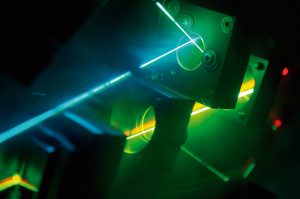

High power thin film optical coatings are typically required for optics that must handle sustained high-power output from lasers. These coatings can be reflecting, transmitting, polarizing, or beamsplitting; it is important to note that "high power" may have different meanings depending on the application. A reasonable definition is that the term "high power" applies to any coating that requires special attention and processing to avoid damage during irradiation. As a rule of thumb, any design drawing that includes a power specification is considered a high-power coating.
As technology and industry evolve, many optical systems have come to rely on high-power laser sources. While standard coating technology can provide cost-efficient, easily reproducible precision results, there are limitations to the durability of standard coatings, particularly when subjected to high intensity irradiation. As a result, specialized high-power optical coatings are often required.
LIDT values can be further increased by manipulating the coating layers in one of several ways. The electric-field distribution can be averaged across several layers, thereby avoiding a high electric-field concentration within a relatively small number of layers. The normalized electric-field intensity (EFI) squared within a reflecting quarter-wave dielectric stack. The peak EFI values occur at layer interfaces and the highest EFIs occur at the layers closest to the air boundary.
For high-power applications, coating designers must choose materials with intrinsically low absorption at the relevant wavelengths, which leaves the designer with only a few material choices in each of the spectral regions. Coatings for use with high-power ultraviolet (UV) light are made of different materials from those for use in the visible and near-infrared (IR). Materials for use in mid- and far-IR coatings are a third group.
Dielectric metal oxides are preferred materials for UV, visible, and near-IR laser applications. Silicon dioxide (SiO2) is the generally accepted and ubiquitous choice for low-index layers. Choosing a material for high-index layers is not as straightforward: oxides of titanium, tantalum, zirconium, hafnium, scandium, and niobium are popular high-index materials.
The design of a coating can significantly alter the damage threshold. In the case of high-reflection coatings, the core structure is typically a repeating stack of high- and low-index layers, each a quarter-wavelength thick. Simply adding a half-wave of low-index material (normally SiO2) as the final layer can result in measurably higher damage thresholds.
According to some groups, laser-damage thresholds can be increased even further by manipulating the coating layers in at least one of several ways. The electric-field distribution can be averaged across several layers, thereby avoiding a high electric-field concentration within a relatively small number of layers. The high-intensity resonant peaks can be shifted from layer interfaces to locations within the film continuum. The highest-intensity resonant peaks can be positioned within the layers of the thin-film material demonstrating the highest damage threshold.